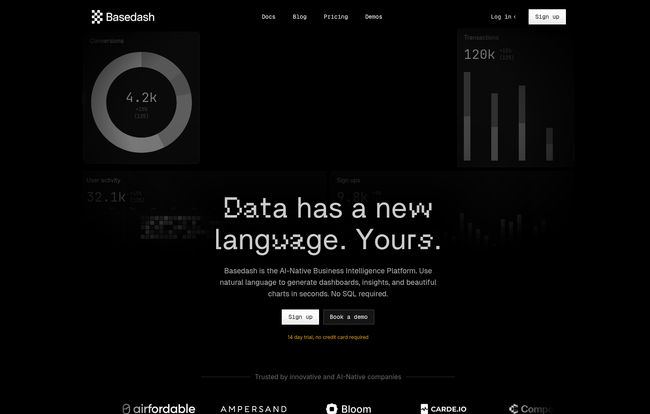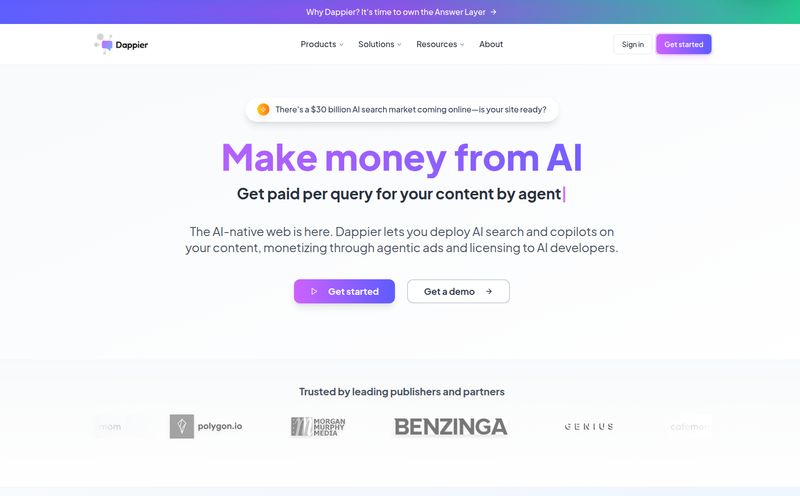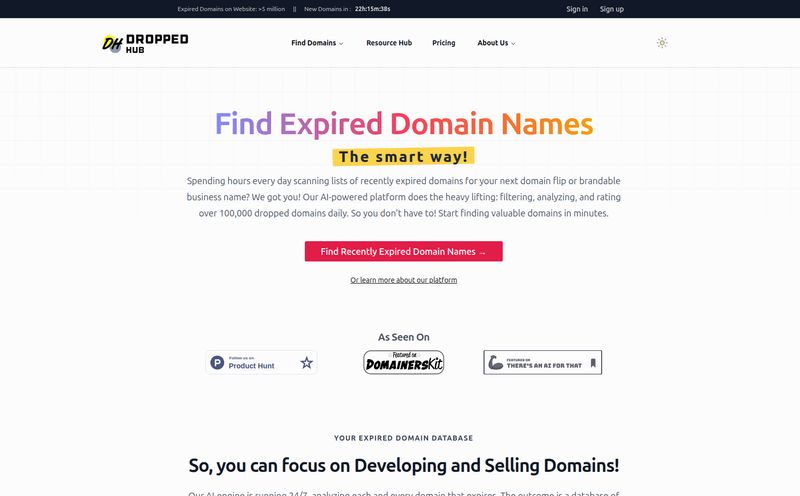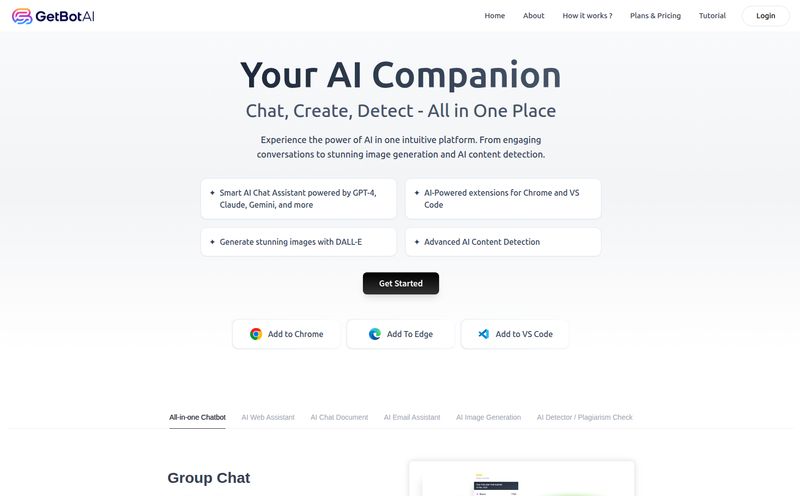As an SEO guy, I live and breathe data. Traffic, rankings, conversions, bounce rates… it’s a constant flood. And for years, the industry has had this one massive gatekeeper standing between you and the answers you need: SQL.
I can’t count the number of times I’ve had a simple question like, “Hey, what was the average conversion rate for users who came from organic search last Tuesday on a mobile device?” and been met with, “Sure, just put in a ticket for the data team.” Two days later, I get a CSV file that’s almost what I asked for. Sound familiar? It's a bottleneck. It’s frustrating. And honestly, it slows down progress.
So when I started hearing whispers about a new kind of business intelligence platform, one that promised you could literally talk to your data, my curiosity was piqued. The tool is called Basedash, and their tagline is bold: “Data has a new language. Yours.” I had to see if it was just clever marketing or the real deal.
So What Is Basedash, Anyway?
At its core, Basedash is an AI-native business intelligence (BI) platform. That’s a lot of jargon, so let me break it down. It’s a tool that connects directly to your company’s databases (think Postgres, Snowflake, MySQL) and your software tools (like Stripe, Google Analytics, etc.). But instead of making you write complex code to get information, it lets you just ask questions in plain English.
You type, “Show me our top 10 customers by revenue this quarter,” and it doesn’t just spit out a table. It generates a clean, beautiful chart or graph visualizing that exact data. It’s designed for the rest of us—the marketers, the founders, the product managers, the sales leads—who need answers now, not after a two-day wait and a masterclass in `SELECT FROM` clauses.

Visit Basedash
The Magic Trick: How You Can Actually Talk to Your Data
The whole experience feels a bit like magic, but it’s built on some pretty solid tech. Let's look under the hood without getting too technical.
Natural Language is the New SQL
This is the main event. The entire user interface is built around a chat box. You connect your data sources, and Basedash’s AI takes a look at your data structure—your tables, columns, and how they relate. It learns your jargon, your KPIs, your internal lingo. Then, you just start asking questions.
What I found pretty cool is that it’s not just a dumb bot. If you ask something a bit vague, it asks for clarification. And if it makes a mistake in the query it writes behind the scenes? The AI automatically tries to fix it. That's a huge step up from staring at a red error message with no clue what a 'syntax error near JOIN' even means.
Connecting to Your Entire Business
A BI tool is only as good as the data it can see. Basedash seems to get this, with over 600 integrations listed. You can hook up your main production database, your data warehouse like Snowflake or BigQuery, and SaaS tools like Stripe or Hubspot. This means you can create a single dashboard that pulls revenue data from Stripe, user behavior from your product database, and marketing campaign performance from your ad platforms. No more toggling between ten different browser tabs to get a complete picture. That, for me, is a game-changer.
From Simple Question to Stunning Dashboard
Asking a one-off question is great, but the real power comes from building permanent dashboards for your key metrics. With Basedash, you can turn any chat query into a chart on a dashboard with a click. You can build out a “Main KPI Dashboard,” a “Marketing Performance” board, or a “Customer Success” overview in minutes. And they look good. Seriously, the aesthetic is clean and modern—a far cry from some of the clunky, dated interfaces I’ve been forced to use in the past.
My Experience: The Good, The Bad, and The AI
Alright, enough with the features. How does it actually feel to use it? I spent some time with the platform, connecting a few data sources to see if it lived up to the hype.
What I Absolutely Love
The ease of use is undeniable. It's just... intuitive. There’s no steep learning curve. Within 30 minutes, I had a basic dashboard running that tracked some key metrics. The barrier to entry is practically non-existent, which is amazing for smaller teams or startups that don't have a dedicated data analyst.
I also have to give them credit for building on ClickHouse. This is a bit of a niche point, but it's important. It means you’re not locked into their proprietary system forever. If you decide to leave Basedash, you can retain all the data. That kind of freedom from vendor lock-in is a big green flag for any growing company.
And for the power users? The ones who actually do know SQL? They have a powerful, VS Code-based SQL editor built right in. So it's not dumbed down; it's just been made accessible.
A Few Things to Keep in Mind
No tool is perfect, right? On the smaller plans, there are some limitations. The "Small" plan caps you at 3 organization members and a certain number of dashboards and charts. For a solo founder or a very small team, it's probably fine. But if you’re a growing marketing team of five, you'd quickly need to jump to the next tier.
My other slight grumble is the classic "Contact Us" for Enterprise pricing. I get why companies do it, but as a buyer, I always prefer transparent pricing across the board. It's a minor point, but one worth mentioning.
How Much Does This Magic Cost? Basedash Pricing Explained
Speaking of price, let's break down the plans. They seem to be targeting a range from startups to larger enterprises, which makes sense.
| Plan | Price | Key Features |
|---|---|---|
| Small | $80 / month | 3 org members, 30+ data connections, 10 dashboards, 100 charts, 1m active rows. |
| Standard | $300 / month | 30 org members, 600+ connections, Unlimited dashboards & charts, Slackbot. |
| Enterprise | Contact for Price | Unlimited members, on-prem deployment, SAML SSO, onboarding & training. |
The Small plan is a good entry point for tiny teams. The Standard plan feels like the sweet spot for most small-to-medium businesses, offering unlimited dashboards and a Slackbot, which is a nice touch for getting alerts. The Enterprise plan is for the big players who need all the security and support bells and whistles like SSO and on-premise deployment.
Is Basedash the Right BI Tool For You?
So, here’s my take. If you’re a hardcore data scientist who loves crafting 200-line SQL queries and fine-tuning every little parameter, Basedash might feel a little too simple for you (though the SQL editor is there if you need it).
But if you are a founder, a marketer, a product manager, or part of any team that feels blocked by a lack of easy data access, Basedash could be a revelation. It genuinely democratizes data analytics. It turns data from a scary, coded language into a simple conversation. For startups and SMBs, especially those backed by places like Y Combinator (which, not surprisingly, is listed as a backer on their site), this tool could drastically speed up decision-making.
Frequently Asked Questions
- Do I really need to know SQL to use Basedash?
- Nope, not at all. That's the whole point! You can get incredibly far just by asking questions in plain English. For those who do know SQL, there's a powerful editor waiting for you.
- What kind of data sources can I connect to Basedash?
- A whole lot of them. It supports major SQL databases like PostgreSQL, MySQL, and SQL Server, data warehouses like Snowflake, Redshift, and BigQuery, and over 600 SaaS applications.
- Is Basedash secure for my company's data?
- They take security seriously. The website prominently displays a SOC 2 Type II certification, which is a high standard for data security and privacy. This is a crucial checkmark for any business handling sensitive customer or financial data.
- How is Basedash different from something like Tableau or Power BI?
- Think of it as a difference in philosophy. Traditional BI tools like Tableau are incredibly powerful but often come with a very steep learning curve, requiring specialized training. Basedash prioritizes speed and ease-of-use through its AI and natural language interface, aiming to make data accessible to everyone in the company, not just analysts.
- Can I try Basedash before I commit to a plan?
- Yes, it looks like they offer a 14-day free trial, and they state that no credit card is required to get started. This is a great way to connect a test database and see if the workflow fits your team.
Final Thoughts
I went into this Basedash review a bit skeptical, as I always am with tools that make huge promises. But I came away impressed. It’s not just a tool; it’s a shift in how we think about interacting with data. It removes the technical expert as a gatekeeper and puts the power directly in the hands of the people with the questions.
Will it replace every data analyst? No. But will it make every team smarter, faster, and more data-informed? I genuinely believe so. In a world drowning in data, Basedash hands you a translator. And that’s pretty powerful stuff.



